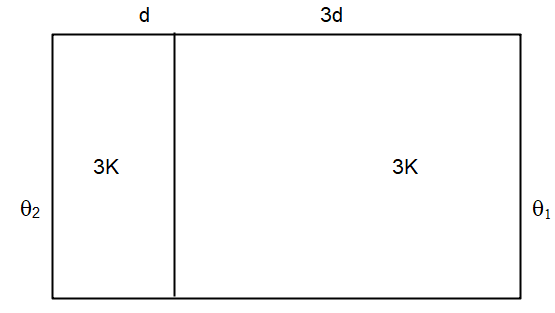Question
Question: Two materials having coefficients of thermal conductivity ′3K′ and ′K′ and thickness 'd' and ′3d′, r...
Two materials having coefficients of thermal conductivity ′3K′ and ′K′ and thickness 'd' and ′3d′, respectively, are joined to form a slab as shown in the figure. The temperature of the outer surfaces are ′θ2′ and ′θ1′ respectively, (θ2>θ1). . The temperature at the interface is?

A) 2θ1+θ2
B) 10θ1+109θ2
C) 3θ1+32θ2
D) 6θ1+65θ2
Solution
Hint : In this solution, we will assume that the system has been in a steady-state for a long time. Then both the slabs will have the same rate of heat transfer and we will use this to determine the solution of the interface.
Formula used: In this solution, we will use the following formula:
Rate of heat transfer in a slab with different temperatures: Q=LkAΔT where A is the area of the surface, ΔT is the temperature difference, and L is the length of the slab.
Complete step by step answer
In the system given to us, we will assume that the system has been left in this situation for a long time. This implies that the heat transfer will have occurred over a long time and the system can be said to have achieved a steady-state.
In this steady-state situation, we can say that the heat transfer in both the slabs will be the same. Let us assume that the temperature of the surface is θ . Then since the heat flow rate is constant for both the surfaces will be the same and we can write
d3kA(θ2−θ)=3dkA(θ−θ1)
Dividing both sides by kA/d and cross multiplying the denominators, we get
9θ2−9θ=θ−θ1
Solving for θ , we get
⇒θ=109θ2+10θ1 which corresponds to option (B).
Note
Unless mentioned otherwise, we must take such systems to be in a steady-state i.e. the system has been in this state for a long time. Only with this assumption can we assume that both the slabs will have the same rate of heat transfer.
